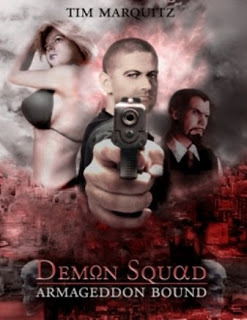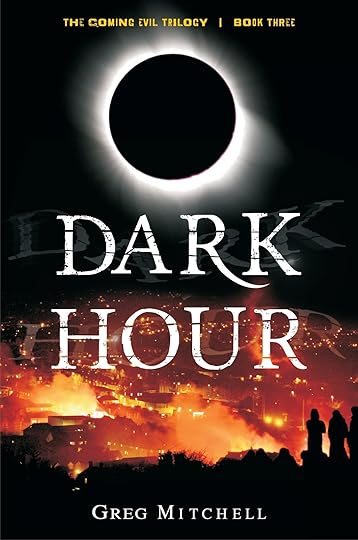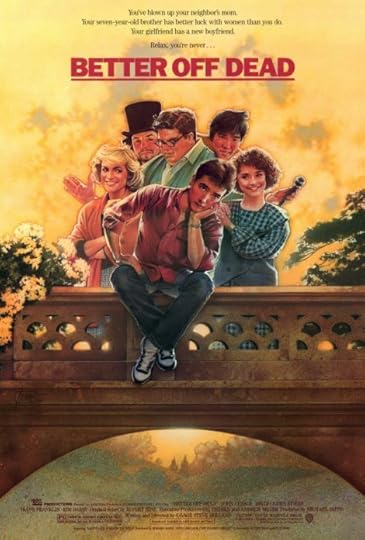Edward M. Erdelac's Blog, page 29
April 24, 2013
The Road Behind: Tim Marquitz Looks Back On His Demon Squad Series
Having just completed my own weird western series, Merkabah Rider with Once Upon A Time in the Weird West, I decided to invite some of my author buds to come on Delirium Tremens and talk about their own series. Greg Mitchell was on here a while back talking about his Coming Evil Trilogy.
This time out I’ve got Tim Marqutiz, author of The Blood War Trilogy and the Demon Squad series, which is now up to book five, Beyond The Veil, and follows the perils of Frank Triggaltheron Trigg, the Devil’s favorite nephew…
TM: When I started the first Demon Squad book, I would never have pictured I’d be sitting here today with five books in the series published and two more in the planning stage. I’m not really sure what I expected, to be honest. Who would have thought a rude, oversexed screw up without a clue would survive the first book let alone five? I sure didn’t, and I wrote the damn things. Seeing the series take off is both humbling and frightening, but like the main character, Frank, I’ve come a long way since the first book in how I view the world.
In terms of writing, the series started off very raw. Armageddon Bound was a clash of styles and ideas all thrown into a blender and pureed. Some worked, some didn’t. There were some very movie/television-oriented aspects (Frank breaking the fourth wall and talking to the reader directly) that I feel added to the charm of the character, such as it was, but have long since vanished from the series. It was fun and interesting, but it simply wasn’t good writing.
There was also the rampant sexual commentary that pervaded the first book. While I felt, most certainly at the time, that it was completely within the bounds of the character I was creating, I’ve since learned to tone that down. He’s no less a dog but it doesn’t come across as obsessive anymore, or at least that’s what I was looking for. In Armageddon Bound, I can see how people, women especially, might consider Frank to be misogynistic to a degree. That definitely wasn’t what I was going for when I envisioned him. He’s simply used to interacting with women who are almost exactly like him in personality, all from a world where such boundaries are far less concrete. He was raised in Hell, you know? Political correctness is a human construction.
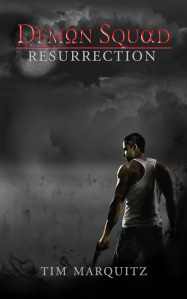 For me, I think that misunderstanding was as issue of translation. I hadn’t quite zeroed in on how to approach his overt sexuality without coming across as offensive. Starting with Resurrection, which was written immediately after Armageddon Bound, I think the change become more evident, me growing alongside the character. Frank is no less sexualized these days, but it’s focused, honed, and dialed in more on the whole of his character rather than as the apparent majority of it. He isn’t just a sex-obsessed guy who gets into fights, but he’s a guy who gets into fights who happens to like boobs. Subtle, I know.
For me, I think that misunderstanding was as issue of translation. I hadn’t quite zeroed in on how to approach his overt sexuality without coming across as offensive. Starting with Resurrection, which was written immediately after Armageddon Bound, I think the change become more evident, me growing alongside the character. Frank is no less sexualized these days, but it’s focused, honed, and dialed in more on the whole of his character rather than as the apparent majority of it. He isn’t just a sex-obsessed guy who gets into fights, but he’s a guy who gets into fights who happens to like boobs. Subtle, I know.
And like the character of Frank, the series has grown and evolved over the stretch of five novels. While originally steeped almost solely in Christian mythos, I’ve built the foundation and gone beyond that. The books still contain plenty of angels and demons and names that are easily identifiable from their source texts, but I’ve since moved away from the constraints of such historical/mythological boundaries. Alongside the classic urban fantasy creatures of werewolves, vampires, and ghosts, I’ve added in aliens and empowered humans and all manner of supernatural beings, and I’ll continue to pervert the character/creature landscape with strange and wonderful entities you might not see anywhere else.
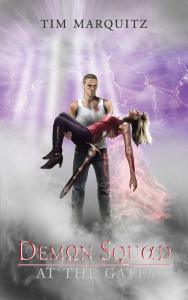 That was definitely the idea from the start. I wanted a world that was unique (or as unique as possible) where a reader is never certain what they might run across. The core of the character and the series will always be there, and anchor of stylistic preference and consistency, but as the series has already shown, it’s not bound by genre classifications. There is a definite influence of Jim Butcher’s style in the series, but that too has become less of a driving force for me and more a solid piece of the support mechanisms that hold the world together. The world has moved on from its narrow beginnings, and I hope it will continue to do so.
That was definitely the idea from the start. I wanted a world that was unique (or as unique as possible) where a reader is never certain what they might run across. The core of the character and the series will always be there, and anchor of stylistic preference and consistency, but as the series has already shown, it’s not bound by genre classifications. There is a definite influence of Jim Butcher’s style in the series, but that too has become less of a driving force for me and more a solid piece of the support mechanisms that hold the world together. The world has moved on from its narrow beginnings, and I hope it will continue to do so.
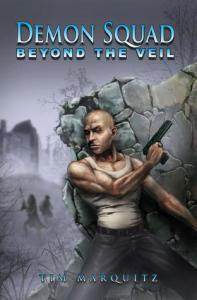 In the end, I believe I’ve dragged the Demon Squad series out of the muck of its early incarnations focused it into one of the more entertaining urban fantasy series out there, combining originality and attitude with the solid foundation of the genre beneath it.
In the end, I believe I’ve dragged the Demon Squad series out of the muck of its early incarnations focused it into one of the more entertaining urban fantasy series out there, combining originality and attitude with the solid foundation of the genre beneath it.
And hey, while Frank might still be a turd, he’s a shiny turd now.
More about Tim can be found at his blog -
You can pick up Demon Squad as well as his other books here -
http://www.amazon.com/Tim-Marquitz/e/B002XIZZH0/ref=sr_tc_2_0?qid=1366851936&sr=8-2-ent


April 19, 2013
Tomorrow, Saturday the 20th, I’ll be appearing at the Buc...
Tomorrow, Saturday the 20th, I’ll be appearing at the Buckaroo Bookshop event talking up weird westerns and palavering about my favorite subject (hint: it’s me) during the 20th Annual Santa Clarita Cowboy Festival at the famous Melody Ranch outside Newhall, CA.
So if you’re around, I’ll be there all day hawking books Saturday and Sunday.
http://cowboyfestival.org/schedule/buckaroo-book-shop/


April 18, 2013
DT Back Issues: The ‘Nam
1983-1995 (the Copper Age) was the height of my comic book collecting, and a great time to discover the medium. Starting with Larry Hama’s GI JOE: A REAL AMERICAN HERO for Marvel and gradually segueing into TRANSFORMERS and GROO THE WANDERER, I started frequenting comic shops and began to pick up anything that caught my eye. The mid 80′s saw the release, in rapid succession, of Frank Miller’s WOLVERINE (with Chris Claremont), DARK KNIGHT RETURNS, Alan Moore’s V FOR VENDETTA, THE WATCHMEN, and THE KILLING JOKE, and other positively seminal works in the field.
But I don’t wanna talk about them. I’m by no means a scholar or expert. I got out of comics for the most part when I started college, only popping in now and then since to pick up the occasional trade collection, LEAGUE OF EXTRAORDINARY GENTLEMEN, SIN CITY, THE WALKING DEAD, a couple CAPTAIN AMERICAs, THE ULTIMATES, stuff like that. All those books have been written up and dissected by far more qualified people than me, and you can look them up anywhere on the internet.
I’ve decided I’d like to revisit comics I’ve kept in the long white boxes in the back of my closet, titles that for whatever reason may not have been the most popular, and indeed, were likely forgotten for the most part, or mostly went underappreciated. I don’t know that I’m talking about rarities, or anything. I wasn’t really an underground comics guy. I’m talking more about mainstream gold that for whatever reason floated off down the creek. Stuff like Andy Helfer’s take on THE SHADOW, THE LAST AMERICAN, MARSHAL LAW, Steve Gerber’s FOOLKILLER miniseries from the 90’s, John Wagner’s BUTTON MAN, and Evan Dorkin’s MILK AND CHEESE.
Are ya with me?
OK, so I’m instituting a new feature here on Delirium Tremens, DT BACK ISSUES. Like DT MOVIEHOUSE, it’ll probably be infrequent, but it’ll give you something to read about besides Merkabah Rider, the Van Helsing Papers, Buff Tea, and anything else writerly I’ve got coming down the pipe.
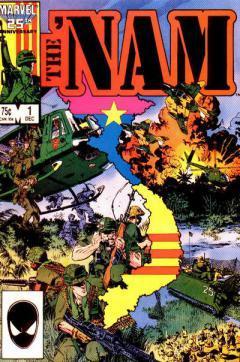 And right now, having just finished re-reading the entire seven year run (or most of it – turned out I was short about four issues towards the end), Marvel Comics’ THE ‘NAM.
And right now, having just finished re-reading the entire seven year run (or most of it – turned out I was short about four issues towards the end), Marvel Comics’ THE ‘NAM.
Assistant Editor Tim Tuohy, in his introduction to the final letter’s page of the series, said THE ‘NAM was referred to as “The Great Experiment” around the Marvel offices.
What an inventive and daring experiment it was! Larry Hama of GI JOE and Doug Murray came up with the idea of doing a realistic comic book about the Vietnam War, not a Sgt. Fury or Sgt. Rock actioner, but a real deal straightforward, grunt’s eye view of the war. Further, it would be told in real time, meaning when a month passed between issues, a month passed for the characters in the book. Given that a tour of duty in Vietnam lasted one year in the 60’s, that meant after twelve issues, the characters introduced in the first issue would rotate back to the United States, and a whole new cast would take over the story.
America was a little Vietnam crazy in the 80’s, and me being 12 years old in 1987 when I picked up my first issue (#11 – just LOOK at that cover! How could I pass up such a great looking book?), I was no different.
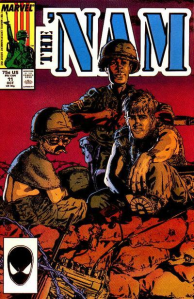 Rambo was the most famous Vietnam vet, and it seemed like every cool, moody character in comics and film had a background in the war. The Punisher, even Stalker, Snake Eyes, Storm Shadow and Scarlet from GI JOE had been to Indian Country (no surprise, given Hama was a vet).
Rambo was the most famous Vietnam vet, and it seemed like every cool, moody character in comics and film had a background in the war. The Punisher, even Stalker, Snake Eyes, Storm Shadow and Scarlet from GI JOE had been to Indian Country (no surprise, given Hama was a vet).
And some time around that year, my buddy Ricardo leant me a VHS copy of Platoon, and the movie just blew me away.
I was gung ho for Vietnam. I wanted to learn everything about the VC and POW’s, M-60′s, Hueys, and humpin’ the boonies. So I picked up The ‘Nam #10 and #11 at my local comic shop.
It was the issue right after a major character and the best friend and mentor of the at the time main character Ed Marks had been killed. It opened with Ed drinking his sorrows away at the post bar while his friends worried over him, and then depicted an action in Saigon with US grunts acting as liaisons with South Vietnamese police.
To my eleven/twelve year old mind, it was totally baffling, and yet engrossing. Like Ed, I had no idea what the heck was going on. I was thrust into this strange world where absolutely nothing was explained. A civilian opened fire on a Vietnamese politician and the police responded by lighting up a crowd with machinegun fire. What had happened? Ed demanded to know, but he got no answers, so neither did I. In another scene, Ramnarain, one of the other soldiers, is shown selling something to a guy on the street. When Ed asks what he thinks he’s doing, Ramnarain’s response is “Just trying to make a little P.” What? Was he making fun of Ed? I had no idea. The lingo was as dense as the storyline. Most comics would have the little asterisks at the bottom of the panel explaining everything or the writing would put the word in such a context that you could figure out the meaning. Not so in The ‘Nam.
At the end of the book I discovered a handy lexicon with definitions of all the slang and military terms (P is money, of course), and letters from actual Vietnam vets and kids like me both expressing their admiration for the first ten issues and lamenting the death of somebody called Mike.
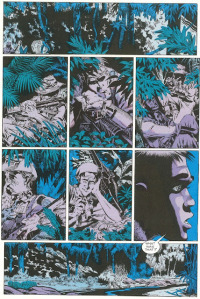 Adding to the uniqueness of THE ‘NAM was its art, which I now recognize as being just glorious, a perfect, but to me (at the time) unheard of melding of cartoon/caricature human figures and astoundingly accurate and detailed equipment and backgrounds. Just look at the exaggerated figures. It’s the same kind of reality-disconnect you experience seeing Roger Rabbit interacting with Bob Hoskins, but here, it jars you, puts you a bit on edge. The characters look too pleasant to do each other violence. Then an orphan kid in line at a dinner sponsored by the Army pulls a grenade out from under his shirt and blows a GI into chuck.
Adding to the uniqueness of THE ‘NAM was its art, which I now recognize as being just glorious, a perfect, but to me (at the time) unheard of melding of cartoon/caricature human figures and astoundingly accurate and detailed equipment and backgrounds. Just look at the exaggerated figures. It’s the same kind of reality-disconnect you experience seeing Roger Rabbit interacting with Bob Hoskins, but here, it jars you, puts you a bit on edge. The characters look too pleasant to do each other violence. Then an orphan kid in line at a dinner sponsored by the Army pulls a grenade out from under his shirt and blows a GI into chuck.
This was the art of Michael Golden, a guy whose other work I’m not familiar with, but keep meaning to hunt up. His tenure ended not long after my own readership began (actually in the eleventh issue, I think).
The book was taken over by Wayne Vansant. A lot of people complained that his work presaged a drop in quality, but I disagree. He may not have been as stunning as Golden, but his art still fit the book like a combat boot, and he did the lion’s share of the work on it, mostly unsung, for a number of years, barring a few guest stints. Around the same time the book went from newsprint to a higher quality paper. This made for more vibrant colors that showcased Vansant’s work, but I think, tamed the book just a tad. The murk of newsprint had stood in for the haze of combat, the mystery of a place where anyone could decide to turn on you at any moment, and only the guys in OD Green beside you could be counted on (and sometimes not even them).
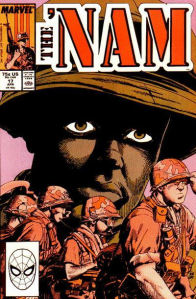 True to its promise, the characters rotated out, and new characters were brought in. Unfortunately this fascinating method of storytelling was abandoned, sometime around the infamous issue #41 or thereafter, and we never found out what happened to a lot of the guys like Andy and Daniels, Light, and the old timer Martini that had grandfathered in from the Korean War.
True to its promise, the characters rotated out, and new characters were brought in. Unfortunately this fascinating method of storytelling was abandoned, sometime around the infamous issue #41 or thereafter, and we never found out what happened to a lot of the guys like Andy and Daniels, Light, and the old timer Martini that had grandfathered in from the Korean War.
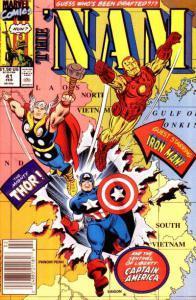 #41 was said to be an attempt to boost sales. It featured The Avengers on the cover, bursting through a map of Vietnam and proclaiming “GUESS WHO’S BEEN DRAFTED?” (look at the little HUH? bubble sprouting out of the GI in the upper left hand corner – was that Doug Murray himself?)
#41 was said to be an attempt to boost sales. It featured The Avengers on the cover, bursting through a map of Vietnam and proclaiming “GUESS WHO’S BEEN DRAFTED?” (look at the little HUH? bubble sprouting out of the GI in the upper left hand corner – was that Doug Murray himself?)
It turned a lot of people off, obviously. I don’t think Doug Murray would’ve done this story unless somebody higher up in Marvel were leaning on him, but on the other hand, I also think that anybody who dismissed THE ‘NAM because of this issue probably saw this in a catalog or on the shelf and scoffed without reading it.
The Avengers don’t REALLY invade Vietnam. How this all came about was, in a previous issue, a misfit private named Aeder had joined the unit (which I should mention, was the 23rd Infantry). Aeder was not a good soldier and didn’t fit in well with the others. Plus, he was constantly reading comic books. A few issues prior to #41 he developed a relationship at the local ville with a Vietnamese girl, and was often being caught by Ice Phillips (the squad’s sergeant) AWOL. One one such excursion, VC guerillas burst into Aeder’s girl’s home while they were lying in bed, and gunned them both down.
In #41, Phillips is about to catch his chopper home, it being the end of his tour. Martini walks in and finds him sitting on Aeder’s cot, going through his old comics. They imagine what the war would be like if superheroes existed and could intervene. That’s it. It’s all Phillips and Martini just smoking and flipping through funnybooks, imagining. No big deal.
Subsequent letters columns EXPLODED with negative feedback on the issue, but re-reading it, it really made me wonder if anybody had read the thing. I was not offended by it in the least. In the end, Murray lasted as the writer only another ten issues before the second attempt by Marvel to bolster sales of the book with a universe crossover happened.
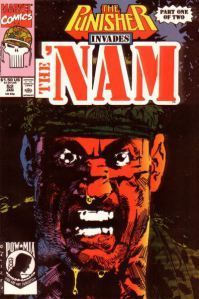 This was #52, Part I of “The Punisher Invades The ‘Nam.”
This was #52, Part I of “The Punisher Invades The ‘Nam.”
This one was well received, and generally, it made more sense. As I mentioned, Frank Castle was already established in his own book as a Vietnam vet. What we saw in this two parter was kind of a prequel to the Punisher, with Marine Corps sniper Frank Castiglione taking on a VC super sniper. A bit into the Sgt Rock mode, but not a bad story.
When it was over though, Murray had been replaced by Chuck Dixon, who abandoned the pre-established real time model and left the 23rd altogether to hop all over Vietnam and tell the stories he wanted to write. He opened with one of the best story arcs of the series, a five parter called The Death Of Joe Hallen, about a Marine’s return home, his disillusionment with the world, his return to Vietnam, and his eventual metaphoric ‘death,’ really a death of spirit. At the end of the arc, Hallen isn’t killed, but after his attempted murder of a fellow soldier (a junkie private named Roeder who mistakenly shot and killed Hallen’s friend as they were coming out of the jungle) is stopped by a couple of MP’s, he is dishonorably discharged and sent off to prison.
After a very slight lag in quality in Murray’s final issues (mostly the look of the book by a couple of fill in artists), the book experienced a renaissance, with Dixon really pulling out the stops. He even revisited the classic squad lineup of the first twelve issues, showing what they were doing (Ed Marks was a war correspondent, Sgt. Polkow a cop, etc). Of these, the biggest and best surprise was Ramnarain, the wheeling and dealing disgruntled private who was last seen when he was captured by the VC some forty issues previously. In a two part story in 59 and 60, a downed pilot is put into a POW camp and steadfastly refuses all attempts at interrogation by the camp commandant. By night he confides with another prisoner, talking through the wall about home, his experiences, etc. The next day the Vietnamese commandant gleefully throws all the info he shared with the GI in the pilot’s face, and as he is dragged out by the guards, the pilot curses the GI for passing information. The guards open the GI’s cell, revealing Ramnarain. Then they pick him up and carry him out. Both legs and an arm have been amputated.
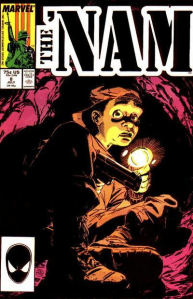 Did I mention this book was telling its stories under the seal of the Comics Code?
Did I mention this book was telling its stories under the seal of the Comics Code?
Yeah. Yet it still managed to deal with issues of racism, drugs, prostitution, CIA torture, civilian massacre, the murder of incompetent superior officers by troops (fragging), the self-immolation of Buddhist monks, the protest movement back home, and the general climate of chaos of the war. Twice, it even told its tales from the point of view of the Vietnamese, ARVN (South Vietnamese Army), NVA (North Vietnamese) and VC guerillas.
There are really too many memorable issues to talk about in depth. Most everybody remembers the Tunnel Rat issue, in which a GI explores a VC tunnel complex and winds up getting trampled by a horde of rats. There was another Punisher storyline (a third was planned and released after the book was cancelled at #84), issues about the American withdrawal and abandonment of its southern Vietnamese allies, and a couple backup stories set at home where a group of the old characters banded together to find their old crooked Top Sergeant who had gone bad in the real world and murdered one of their little brothers in a drug deal (though Dixon slightly effed the continuity up a bit, ignoring the fact that Top had returned to Vietnam after his initial arrest on bribery charges….also at one point Ice Phillips was inexplicably called Ice Eisenman).
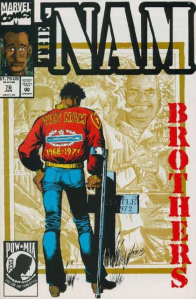 THE ‘NAM opened up the war to me in ways no history book or class ever has, to the point where I learned even more on my second read through. Originally billed as an eight year limited series, it missed its goal by only twelve issues, succumbing at last to flagging sales and the gatefold foil covers of its competitors.
THE ‘NAM opened up the war to me in ways no history book or class ever has, to the point where I learned even more on my second read through. Originally billed as an eight year limited series, it missed its goal by only twelve issues, succumbing at last to flagging sales and the gatefold foil covers of its competitors.
The INCOMING letters column was as educational as the book itself, and hosted spirited debates between combat veterans and war protestors, provided service information for vets and served as a bulletin board for comrades looking to reunite with old buddies, or sons and daughters looking to hear from anybody who had known the loved ones they’d lost. At times the letters printed were more emotional and moving than any fiction Murray or Dixon or any of the other writers ever came up with.
It really was an important comic book, a total anomaly in any collection. 84 issues offering a holistic, illustrated view of a war most schools won’t teach you anything about.
In the last INCOMING, Lizabeth Collier, who I believe was a frequent writer to the back pages, closed out the series saying;
“Don’t allow yourselves and your work to walk off the scene, forgotten. For now, my thanks for your work.”
I couldn’t say it any better.


April 13, 2013
Merkabah Rider: Once Upon A Time In The Weird West Now Available
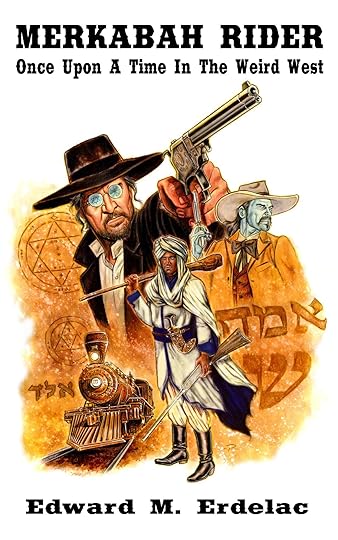 Today everybody’s favorite wandering Hasidic gunslinger walks off into the sunset.
Today everybody’s favorite wandering Hasidic gunslinger walks off into the sunset.
Merkabah Rider 4: Once Upon A Time In The Weird West, is now available most everywhere.
It’s high noon for the universe, and the Outer Gods are stirring in their slumber. Adon has gathered the Creed, his brotherhood of traitorous merkabah riders, as well as a host of dark allies including Navajo skinwalkers, an order of death worshipping monks, an master gunslinger cobbled together from the corpses of famous gunfighters, Lilith the Queen of Demons, and the fallen angel of death Samael himself to bring the Hour of Incursion about.
The Rider and Kabede, last of the Sons of The Essenes, form their own company to oppose him, including a fanatical preacher more steam engine than man, a pagan witch, a skilled kung fu nun, and of course Faustus Montague, an angel from another universe.
But from the capitol of hell, Lucifer waits to throw his legions in with the winning side…
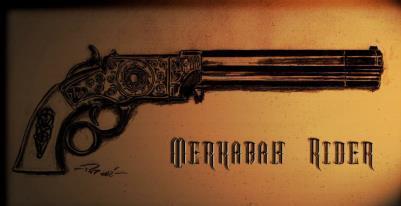 For four years the Rider’s taken me along on his journey across the demon haunted old west, tangling with tentacular entities, possessed gunmen, invisible monsters, throwing down on gunmen, demons, and other horrors. He’s taught me about the fascinating richness of Jewish faith and folklore, and I’ve grown as a writer relating his saga.
For four years the Rider’s taken me along on his journey across the demon haunted old west, tangling with tentacular entities, possessed gunmen, invisible monsters, throwing down on gunmen, demons, and other horrors. He’s taught me about the fascinating richness of Jewish faith and folklore, and I’ve grown as a writer relating his saga.
For that I’m eternally thankful.
Shalom, old demonpuncher.
Here’s a brief excerpt for you all.
——————
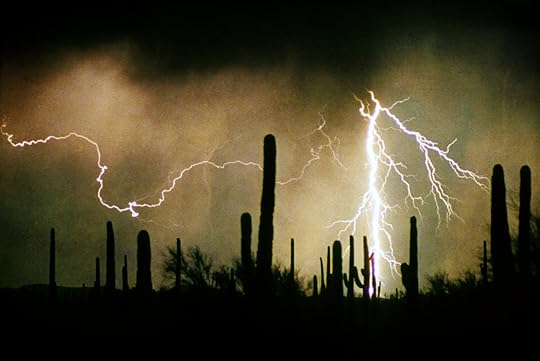 A whip chain of lightning lashed across the black sky, illuminating the landscape in a rapid series of photographer’s blue flashes, and if the Reverend’s heart had been capable of skipping a beat, it would have.
A whip chain of lightning lashed across the black sky, illuminating the landscape in a rapid series of photographer’s blue flashes, and if the Reverend’s heart had been capable of skipping a beat, it would have.
Below them, crossing the dark plain, advancing through the tempest pounding towards the house, was an army of nightmares pressed from Hell.
The Reverend saw hundreds of creatures creeping across the desert. It was as if the buried bones of the country had risen up all at once. He saw a herd of bleached white cattle, dried leather whipping on the bones like the wind torn rags of derelict sailing ships, thundering alongside a group of long dead buffalo. A pack of rotting coyotes ran beside shambling, skeletal bears, though no bears had been in these parts in ages. There were cadaverous human shapes, too, and fast moving, long tailed, reptilian forms. These were creatures of ages past, roused unnaturally from their long torpor. He saw a dozen of those prehistoric horrors, with black clad, armed riders mounted on their spiny backs. Large scissor-billed avian skeletons wheeled overhead, beating the black sky with impossible bone wings, ranging ahead of the undead host, some of them big enough to pick up a horseman in each bare, taloned foot.
Most terrible of all, he saw an immense human skeleton, maybe twenty feet tall, drag itself up out of the muddy ground, the rain melting the sediment of eons from its tree trunk-thick brown bones. The sloped crown of its massive skull was elongated, inhuman, and the huge, sorrowful eye sockets were black and deep as the gulfs in which curled every twisted nightmare, every prickling dread and doubt that plagued the restless in the dead of night.
The Reverend had to lean on a boulder to keep from falling to his knees, and though he was immovable, the howling wind did its best to blow him from the hill.
Good God, what were they?
—-
Pick it up here -


April 7, 2013
DT Moviehouse Review: Big Trouble In Little China
Time once more for my blog feature, DT Moviehouse Reviews, in which I make my way alphabetically through my 200+ DVD/Blu-Ray collection (you can see the list right here) and decide if each one was worth the money. Today I review John Carpenter’s 80′s fantasy adventure Big Trouble In Little China.
(1986) Directed by John Carpenter
Screenplay by Gary Goldman and David Z. Weinstein
Tagline:
Jack Burton is in for some serious trouble. And you’re in for some serious fun.
What It’s About:
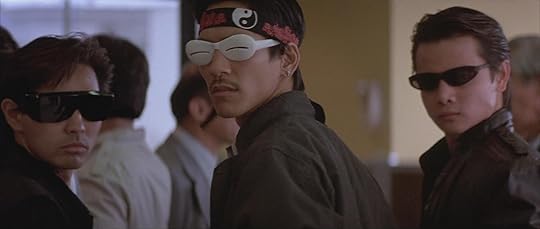 When Miao Yin (Suzee Pai), the green eyed girl of swaggering long haul livestock trucker Jack Burton (Kurt Russell)’s buddy Wang Chi (Dennis Dun) is kidnapped by Chinese gangsters and dragged off into the mysterious underworld of San Francisco’s Chinatown, they pursue her kidnappers in Jack’s rig, The Porkchop Express. Stumbling upon a brutal streetfight between the Chang Sings and the Wing Kong, rival tong factions, Jack and Wang witness the arrival of a supernatural entity called Lo Pan (David Wong) and his three mystically superpowered henchmen, the Storms, and are forced to abandon his truck. Uncovering centuries old ghostly happenings, Jack and Wang must enlist the aid of wily old sorcerer Egg Chen (Victor Wong), crusading lawyer Gracie Law (the lovely Kim Cattrall), and others to rescue Miao Yin and defeat Lo Pan.
When Miao Yin (Suzee Pai), the green eyed girl of swaggering long haul livestock trucker Jack Burton (Kurt Russell)’s buddy Wang Chi (Dennis Dun) is kidnapped by Chinese gangsters and dragged off into the mysterious underworld of San Francisco’s Chinatown, they pursue her kidnappers in Jack’s rig, The Porkchop Express. Stumbling upon a brutal streetfight between the Chang Sings and the Wing Kong, rival tong factions, Jack and Wang witness the arrival of a supernatural entity called Lo Pan (David Wong) and his three mystically superpowered henchmen, the Storms, and are forced to abandon his truck. Uncovering centuries old ghostly happenings, Jack and Wang must enlist the aid of wily old sorcerer Egg Chen (Victor Wong), crusading lawyer Gracie Law (the lovely Kim Cattrall), and others to rescue Miao Yin and defeat Lo Pan.
Why I Bought It:
Big Trouble In Little China is my favorite John Carpenter movie. It foresaw the Hong Kong action cinema craze of the nineties by nearly a decade, and predictably, found no audience upon its release.
I saw it on video with a buddy and his cousin, and loved it out of the gate. I had never seen anything like it. It’s hilarious, action packed, visually exciting, full of awe-inducing practical FX by Richard Edlund, has one of Carpenter’s best synth scores (the whole thing sounds like an 80’s arcade game, which is fitting as its plot probably inspired a slew of them) and has what I think is unequivocally one of the most audaciously conceived and inspired protagonists in all of popcorn cinema; Jack Burton.
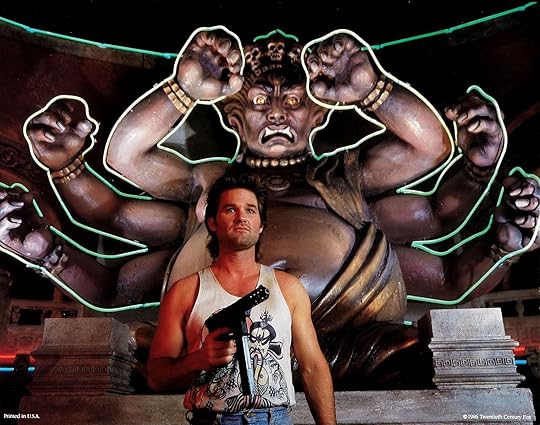 Jack is a blustery, overconfident braggart who’s seen too many John Wayne and Eastwood flicks (he carries around a pair of saddlebags like The Man With No Name) and is at nearly every turn, in over his head. He’s a total fool. He’s a horrible liar, his jokes fall flat, he’s never fired a gun (as evidenced when he nearly fails to blast a Wing Kong attacker because the safety’s still on his Tec-9. When he manages to squeeze a few timely shots off and blinks thoughtfully at the dead man, Eddie asks “First time you ever plugged somebody?” Jack immediately recovers his former loping posture and shrugs, annoyed. “’Course not!”), and he charges into everything like a bull in a china shop (no pun intended). He’s the big dumb American cowboy stomping through a supernatural kung fu flick.
Jack is a blustery, overconfident braggart who’s seen too many John Wayne and Eastwood flicks (he carries around a pair of saddlebags like The Man With No Name) and is at nearly every turn, in over his head. He’s a total fool. He’s a horrible liar, his jokes fall flat, he’s never fired a gun (as evidenced when he nearly fails to blast a Wing Kong attacker because the safety’s still on his Tec-9. When he manages to squeeze a few timely shots off and blinks thoughtfully at the dead man, Eddie asks “First time you ever plugged somebody?” Jack immediately recovers his former loping posture and shrugs, annoyed. “’Course not!”), and he charges into everything like a bull in a china shop (no pun intended). He’s the big dumb American cowboy stomping through a supernatural kung fu flick.
And the great thing about him is, it works for him. There is an adage that God watches over drunkards, children, and fools. It’s implied that Jack is two out of the three. He knocks himself out exuberantly blowing chunks of stone from the ceiling, gets pinned under a heavily armored guard, and is easily bested even by the butterfly knife toting punks at the airport (When the littlest of the punks Jack tries to buffalo whips out a telescoping steel baton, Jack looks confused. “Hey….where’d you get that?” Always makes me laugh out loud). But in the zero hour, when it counts the most, somehow, beyond all reason, Jack comes through in spades.
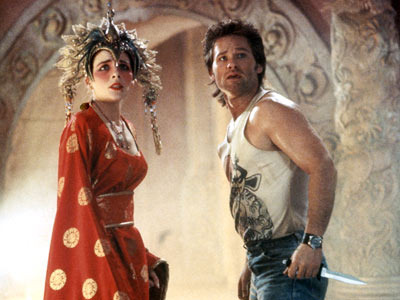 My fellow writer and movie buff Derrick Ferguson blew my understanding of the character wide open when he observed that Jack Burton is NOT the main character of Big Trouble In Little China. He’s the sidekick. He’s the comic relief. But his ego and self-delusion doesn’t allow him to believe he’s not the hero. Really the story is Wang Chi’s. He’s the earnest one out to save his girl, and he’s an extremely adept fighter. Even Egg Chen’s motivations are more compelling. Jack just blundered into everything. He’s just a guy that hauls pigs for a living.
My fellow writer and movie buff Derrick Ferguson blew my understanding of the character wide open when he observed that Jack Burton is NOT the main character of Big Trouble In Little China. He’s the sidekick. He’s the comic relief. But his ego and self-delusion doesn’t allow him to believe he’s not the hero. Really the story is Wang Chi’s. He’s the earnest one out to save his girl, and he’s an extremely adept fighter. Even Egg Chen’s motivations are more compelling. Jack just blundered into everything. He’s just a guy that hauls pigs for a living. 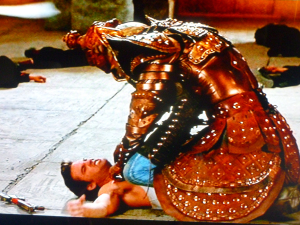 The only thing at stake for him is his truck. Granted, The Porkchop Express is his livelihood and a big deal for him, but Lo Pan’s taking of it is a footnote to the story. He’s not going to take over the world with Jack’s truck, and indeed, the recovery of The Porkchop Express is even treated as a sidenote to the action. “There’s my truck,” Jack mumbles as he pulls open a door, then does a double take, as if even the screenwriters have forgotten about it. “My TRUCK!”
The only thing at stake for him is his truck. Granted, The Porkchop Express is his livelihood and a big deal for him, but Lo Pan’s taking of it is a footnote to the story. He’s not going to take over the world with Jack’s truck, and indeed, the recovery of The Porkchop Express is even treated as a sidenote to the action. “There’s my truck,” Jack mumbles as he pulls open a door, then does a double take, as if even the screenwriters have forgotten about it. “My TRUCK!”
 Another great draw of Big Trouble is James Hong’s Lo Pan. The nature of Lo Pan’s curse means he is at times a young, tall, imposing, graceful warlord in resplendent mandarin garb – but a totally insubstantial ghost – and at others, a withered, cantankerous, crippled old man trembling in a wheel chair. Hong manages to make both incarnations utterly distinct and yet tie them together with a malevolent jubilance that comes through in his shrill, cackling laughter and apparently incongruous modernisms. Old Lo Pan has some of the funniest lines in the movie, and his speech and dialogue were endlessly quoted by my circle of friends as a kid (“Who are these? Friends of yours? Now this really pisses me off to no end!”). The young Lo Pan is magnificently imposing, dark and intriguing, and totally believable in his silky, seductive manipulations of Grace Law and Miao Yin. The fact that both aspects are played by the same actor is a testament to that actor’s skill.
Another great draw of Big Trouble is James Hong’s Lo Pan. The nature of Lo Pan’s curse means he is at times a young, tall, imposing, graceful warlord in resplendent mandarin garb – but a totally insubstantial ghost – and at others, a withered, cantankerous, crippled old man trembling in a wheel chair. Hong manages to make both incarnations utterly distinct and yet tie them together with a malevolent jubilance that comes through in his shrill, cackling laughter and apparently incongruous modernisms. Old Lo Pan has some of the funniest lines in the movie, and his speech and dialogue were endlessly quoted by my circle of friends as a kid (“Who are these? Friends of yours? Now this really pisses me off to no end!”). The young Lo Pan is magnificently imposing, dark and intriguing, and totally believable in his silky, seductive manipulations of Grace Law and Miao Yin. The fact that both aspects are played by the same actor is a testament to that actor’s skill.
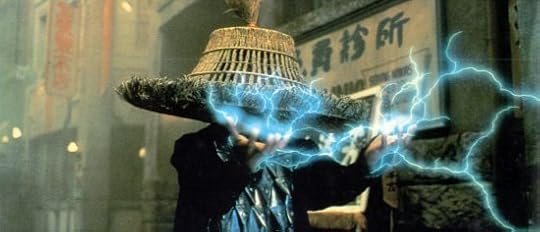 The movie is wonderfully imaginative. There’s the aforementioned three badass henchmen, The Three Storms, obviously inspired by Kazuo Koike’s basket-headed master assassins the Hidari Brothers (or The “Bentenrai”) from the Lone Wolf and Cub manga and film series, one of which generates brilliant chains of wild lightning with a series of furious martial art wind-ups (and in turn inspired Mortal Kombat’s Raiden character). Lo Pan spies on interlopers with a kind of floating D&D Beholder with an eyeball on the end of its tongue. Egg buffs his allies with super powered awareness and abilities via a smoking Dr. Frankenstein potion from his mysterious six demon bag, from which he also pulls a jewel that allows him to engage in a sorcerous bout of virtual Street Fighter with Lo Pan. For some reason there’s some kind of monstrous fanged wildman running around.
The movie is wonderfully imaginative. There’s the aforementioned three badass henchmen, The Three Storms, obviously inspired by Kazuo Koike’s basket-headed master assassins the Hidari Brothers (or The “Bentenrai”) from the Lone Wolf and Cub manga and film series, one of which generates brilliant chains of wild lightning with a series of furious martial art wind-ups (and in turn inspired Mortal Kombat’s Raiden character). Lo Pan spies on interlopers with a kind of floating D&D Beholder with an eyeball on the end of its tongue. Egg buffs his allies with super powered awareness and abilities via a smoking Dr. Frankenstein potion from his mysterious six demon bag, from which he also pulls a jewel that allows him to engage in a sorcerous bout of virtual Street Fighter with Lo Pan. For some reason there’s some kind of monstrous fanged wildman running around.
 Among all this madness, I love that the Chinese characters take every incredible happening for granted as reality. It’s a funny contrast to Jack’s astonishment at everything he sees. In my opinion, the fact that nothing is really overly explained reinforces this cultural disconnect. At one point they travel to Lo Pan’s lair by passing through some subterranean passage bubbling with rivers of black blood (“You mean oil?” “I mean black blood of the earth.”) and apparently teeming with creepy crawly man eating abominations (“It will come out no more!” “What? Huh?! What’ll come out no more?!”). Egg, a kind of Chinese Van Helsing, rattles off a legend about the surface of the earth turning over a thousand years ago, and deflects all of Jack’s (and our) western questions with one line, infuriatingly vague answers.
Among all this madness, I love that the Chinese characters take every incredible happening for granted as reality. It’s a funny contrast to Jack’s astonishment at everything he sees. In my opinion, the fact that nothing is really overly explained reinforces this cultural disconnect. At one point they travel to Lo Pan’s lair by passing through some subterranean passage bubbling with rivers of black blood (“You mean oil?” “I mean black blood of the earth.”) and apparently teeming with creepy crawly man eating abominations (“It will come out no more!” “What? Huh?! What’ll come out no more?!”). Egg, a kind of Chinese Van Helsing, rattles off a legend about the surface of the earth turning over a thousand years ago, and deflects all of Jack’s (and our) western questions with one line, infuriatingly vague answers.
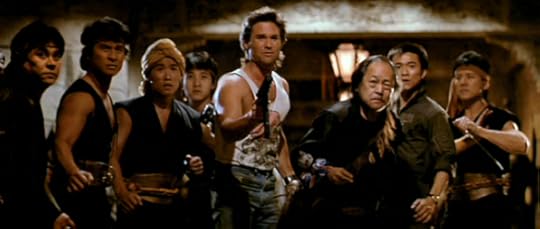 I understand this movie has sometimes been panned as racist, but really, that’s hokum. Although the main villains are Chinese, so are the heroes, and frankly, when I first saw Big Trouble, I don’t think I’d seen such badass depictions of Asian people since Enter The Dragon. The fight in the alleyway is still an exciting bit of martial arts action, featuring some awesome stick and sword fighting. It’s also peppered with familiar faces like Bruce Lee’s Filipino student Dan Inosanto (who crossed sticks with his sifu in Game of Death), the great Al Leong (who warrants his own blog post I’ve gotta get to one of these days), and memorably, Gerald Okamura as what can only be described as some kind of zen gunfighter.
I understand this movie has sometimes been panned as racist, but really, that’s hokum. Although the main villains are Chinese, so are the heroes, and frankly, when I first saw Big Trouble, I don’t think I’d seen such badass depictions of Asian people since Enter The Dragon. The fight in the alleyway is still an exciting bit of martial arts action, featuring some awesome stick and sword fighting. It’s also peppered with familiar faces like Bruce Lee’s Filipino student Dan Inosanto (who crossed sticks with his sifu in Game of Death), the great Al Leong (who warrants his own blog post I’ve gotta get to one of these days), and memorably, Gerald Okamura as what can only be described as some kind of zen gunfighter.
The Chinese characters are not all martial artists either. Eddie (Donald Li), Wang (well OK, Wang is), Egg, and Uncle Chu (Chao Li Chi) come across as very real people, despite their involvement in supernatural matters. Even Lo Pan is a believable character. I admit I still don’t get why Thunder blows himself up at his master’s death beyond the obvious and culturally incorrect seppuku explanation.
Going back once more to the zen gunfighter thing, along with Jack’s saddlebags, I think that’s a throwback to the original script. Big Trouble was originally written as a weird western and Jack was out to recover his beloved horse. I’ve never read the first draft, but it’s interesting to think of what kind of movie it would’ve been.
I gotta mention the end title song sung by the Coup De Villes (John Carpenter’s band featuring himself, Tommy Lee Wallace – director of my all time favorite Halloween movie, Season of The Witch – and Nick ‘Michael Meyers’ Castle), which sounds to me like its meant to be Jack and Wang singing. I have nothing in particular to say about it, I just love it.
Best Dialogue:
“You were not brought upon this world to ‘get it,’ Mr. Burton.”
Best Scene:
No question the scene where Jack takes out Lo Pan.
Up until this point Jack hasn’t really distinguished himself in any way. Wang Chi has upstaged him, he spent the first half of the climactic big fight unconscious and the second part pinned underneath a heavily armored guard.
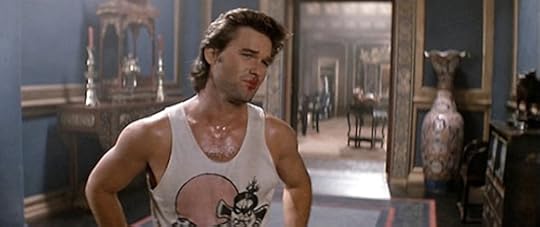 He finally gets an honest kiss out of his would-be girl Gracie Law, but then steps up to the newly made flesh Lo Pan and Thunder (about to kill Miao Yin to break his curse once and for all) with her lipstick smeared across his lips and teeth, undermining his big confrontational speech. He’s taken down a further notch when he intones “Yeah, you know what old Jack Burton always says….” And Thunder interrupts with “Who?!”
He finally gets an honest kiss out of his would-be girl Gracie Law, but then steps up to the newly made flesh Lo Pan and Thunder (about to kill Miao Yin to break his curse once and for all) with her lipstick smeared across his lips and teeth, undermining his big confrontational speech. He’s taken down a further notch when he intones “Yeah, you know what old Jack Burton always says….” And Thunder interrupts with “Who?!”
Wang closes with Thunder and the two take their battle offscreen as Jack takes out his trusty knife and flings it at Lo Pan.
Lo Pan steps aide easily and it clangs into a gong.
Jack takes a deep “Goddammit” breath and glances at Gracie who sighs and gives him a hilarious, “Aw, Jack” look.
Miao Yin breaks away from Lo Pan and rushes to Jack’s side as Lo Pan stoops to retrieve the knife and examines it in his long taloned fingers.
“Good knife. Goodbye, Mr. Burton.”
Lo Pan throws the knife at Jack.
Jack plucks it out of the air and throws it back, sending it dead center into Lo Pan’s forehead, between his two surprised eyes.
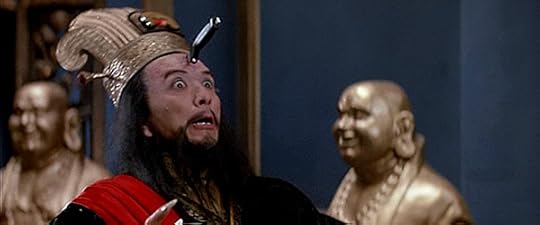 Pan topples over, the room rumbles as his spirit departs, and the lines of golden ceramic Buddhas flanking Jack in the center of the aisle collapse and smash like dominos.
Pan topples over, the room rumbles as his spirit departs, and the lines of golden ceramic Buddhas flanking Jack in the center of the aisle collapse and smash like dominos.
Jack looks at Gracie and Miao Yin, who are both as astounded as the audience.
Savoring what’s probably the one truly cool moment of his life, he shrugs.
“It’s all in the reflexes.”
I don’t know if I can adequately convey the hilarity and excellence of this scene. Even watching it now I still got a momentary chill. When I and my eleven year old buddies saw it for the first time, we nearly drove the couch down through the floor into the basement whooping it up and jumping up and down in excitement.
Would I Buy It Again? Yes. The DVD purchase is alone worth it because of Carpenter and Russell’s commentary, one of the top three commentaries I’ve ever listened to. It’s hilarious. You can hear their liquor glasses clinking throughout the audio, and they steadily laugh more and more at both the movie and each other.
Next In The Queue: The Black Swan


April 5, 2013
JournalStone Publishing’s Award Winning 99 Cent Weekend
Something from the publishers of Terovolas, my Van Helsing in Texas novel, which is on sale all weekend.
The JS award winning 99 cent weekend is here. The Devil of Echo Lake, Twice Shy, That Which Should Not Be, Terovolas and The Void are all on sale through Sunday for 99 cents on Amazon. If you were looking for one of these books, now is the time to buy.


April 3, 2013
Sea Of Trees Appearing In After Death, Now On Sale
 Out now from Dark Moon Books is AFTER DEATH, a new anthology from Bram Stoker nominated editor Eric Guignard, and featuring my story Sea Of Trees.
Out now from Dark Moon Books is AFTER DEATH, a new anthology from Bram Stoker nominated editor Eric Guignard, and featuring my story Sea Of Trees.
The unifying theme of AFTER DEATH is an exploration of the afterlife, or what occurs at the moment of death.
The TOC includes thirty-four all-new tales presented by Steve Rasnic, Bentley Little, John Langan, Simon Clark, Lisa Morton, Joe McKinney, William Meikle, Ray Cluley, David Tallerman, John Palisano, and more.
My own story follows a hapless, depressed ex-accountant as he takes what may be his last walk through Japan’s infamous Aokigahara Forest at the base of Mt. Fuji, notorious as a traditional site for the practice of ubasute and suicide since feudal times.
Ubasute (“abandoning an old woman”) was the practice of poor villagers, usually in times of famine, taking elderly or infirm relatives deep into the wilderness where they were abandoned to die.
Aokigahara is to this day the second most popular suicide site in the world, next to the Golden Gate Bridge. People simply park their cars and wander into the woods, never to return. The trees are littered with personal affects and suicide notes, the branches strung with severed hanging ropes.
I first became aware of the Aokigahara Forest when VICE Magazine did a video segment on the volunteer suicide patrol which does its best to find and prevent suicides.
AFTER DEATH can be purchased directly at AMAZON:
At Barnes & Noble:
http://www.barnesandnoble.com/w/after-death-eric-j-guignard/1114967789?ean=9780988556928
PUBLISHERS WEEKLY says the following about this book (and mentions my own effort):
“What happens when we die? The answers come in the form of 34 stories that explore diverse notions . . . Though the majority of the pieces come from the darker side of the genre, a solid minority are playful, clever, or full of wonder. This strong and well-themed anthology is sure to make readers contemplative even while it creates nightmares.”
http://www.publishersweekly.com/978-0-9885569-2-8
So take a look at it.
Hasta pronto.


April 2, 2013
Evil Jester Bringing Horror Comics Back EC Style
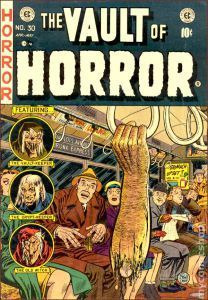 Evil Jester Press is in the last twelve days of its kickstarter campaign for the first four issues of Evil Jester Presents, a comic book horror anthology series in the same vein as Tales From The Crypt and The Vault of Horror.
Evil Jester Press is in the last twelve days of its kickstarter campaign for the first four issues of Evil Jester Presents, a comic book horror anthology series in the same vein as Tales From The Crypt and The Vault of Horror.
They have some great talent lined up for their premier issues, including Jack Ketchum, Ramsey Campbell, Jonathan Maberry, Gary Braunbeck, William (Logan’s Run) Nolan, Joe McKinney, and oh yeah…me.
Yep, as of now, I’m scheduled to make my comic book debut in one of the first four issues with an adaptation of my weird western tale of sasquatches, Texas Rangers, and Comanches, BIGFOOT WALSH.
Check out the promo video -
So spread the word, make a pledge, do both, or either.
Here’s their page -
And here’s a complete list of all accepted authors for the first four issues…
1.) Joe McKinney – “Swallowed”
2.) Gregory Norris – “O Christmas Tree”
3.) Mark C. Scioneax – “Riser”
4.) Gary Braunbeck – “We Now Pause for Station Identification”
5.) Benjamin Kane Ethridge – “Scissors”
6.) Holly Newstein Hautala – “Ballad of Silas Yoder”
7.) Vince Liaguno – “Night Nurse of Cobblestone”
8.) Jack Ketchum – “Polaroids”
9.) Charles Day – “The Gift”
10.) David Hayes – “Judith”
11.) Taylor Grant – “The Vood”
12.) Aric Sundquist – “The Fifth Room”
13.) Suzanne Robb – “Threshold”
14.) Jeremy C. Shipp – “Balloon Boy”
15.) Jonathan Maberry – “Like Part of the Family”
16.) Jason V Brock – “The Underground”
17.) Tim Waggoner – “Long Way Home”
18.) Jeff Strand – “Aunt Betty’s Basement”
19.) Ramsey Campbell – “Call First”
20.) Mort Castle – “Party Time”
21.) Michael C. Lea – “Earthbound”
22.) Marianne Halbert – “A Used Infinity”
23.) Robert Shane Wilson – “What Happens in Vegas”
24.) Edward M. Erdelac – “Bigfoot Walsh
25.) Gene O’Neill – “Masque of the Red Horde”
26.) William F. Nolan – “The Underdweller”
27.) Jim Chambers – “Observation Effect”
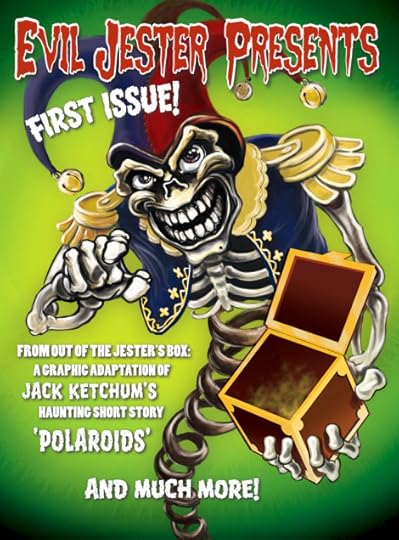


March 21, 2013
The Coming Evil Trilogy: A Retrospective by Greg Mitchell
Today I hand the blog over to my pal and fellow Star Wars alumn Greg Mitchell, who just finished publishing his Coming Evil trilogy. With my own Merkabah Rider series drawing to a close, I thought it’d be interesting to hear what he had to say about completing a work that’s taken up so many years and so much effort.
Is it common for writers to experience “empty nest” syndrome?
For the first time in nearly fifteen years, I don’t have any more writing to do on The Coming Evil Trilogy. It’s done. Over. They’re all out now, available for your purchase. Some characters met their demise, some found their true calling. But there’s nothing left to say, no more battles left to write.
The books are finished. And I’m not sure where to go from here…
Here we are, a month after I released Dark Hour, the third and final installment in the Trilogy, and it’s only now slowly beginning to settle in that I finished what I started when I was twenty years old.
 For the uninitiated, The Coming Evil Trilogy tells the story of the once-scenic Greensboro, a small town in its death throes thanks to the highway being moved a few miles to the left. The economy has shriveled up—the people have shriveled up. Their apathy has attracted the attention of the enigmatic “Strange Man” a gleefully sadistic demon with a leather fetish, and his army of pint-sized flesh-eating gremlins. The Strange Man has a bone to pick with Greensboro for banishing him over a hundred years ago, but his true sinister intent isn’t revealed until the very end of the series. For three books, we encounter a ragtag group of small town folk who must combat these hellish hordes with something that they’ve all forgotten—faith. And so begins the terrifying blood-soaked struggle to discover what is worth fighting for in their lives, what is worth hanging onto. At its core, The Coming Evil Trilogy is a coming-of-age tale, where boys become men and shoulder the mistakes of the previous generation while trying to decide how they will impact their world.
For the uninitiated, The Coming Evil Trilogy tells the story of the once-scenic Greensboro, a small town in its death throes thanks to the highway being moved a few miles to the left. The economy has shriveled up—the people have shriveled up. Their apathy has attracted the attention of the enigmatic “Strange Man” a gleefully sadistic demon with a leather fetish, and his army of pint-sized flesh-eating gremlins. The Strange Man has a bone to pick with Greensboro for banishing him over a hundred years ago, but his true sinister intent isn’t revealed until the very end of the series. For three books, we encounter a ragtag group of small town folk who must combat these hellish hordes with something that they’ve all forgotten—faith. And so begins the terrifying blood-soaked struggle to discover what is worth fighting for in their lives, what is worth hanging onto. At its core, The Coming Evil Trilogy is a coming-of-age tale, where boys become men and shoulder the mistakes of the previous generation while trying to decide how they will impact their world.
Not only is this a coming-of-age tale for my characters, but it’s been a bit autobiographical as well. You see, I had something to prove, too. I began writing the first book in the series—The Strange Man—back in 1998/99. I was a young screenwriter with a two-fold passion: I loved monsters, especially the creature features of the 1980s, and I wanted to work in Christian films. However, at the time, I noticed a depressing trend in the Christian Film Market. They were heavy on the message, or the “sermon”, but at the expense of things like characters, plot, action, subtext. It wasn’t surprising. At the time, Christian films were super low budget. They were only about a half-hour long and were made explicitly as “gospel tracks” to be viewed on Wednesday night Church Youth Group pizza parties. They weren’t meant for entertainment, but to get their message across in a short amount of time and serve as an ice breaker for future conversations.
But I was just out of high school and I wanted to be different. I wanted to blaze new trails! I wanted to prove that you could have your “message”, but that it could grow organically out of an engaging story with real, believable, relatable characters. I was convinced the story could be fun and exciting, all on its own! I was desperate to prove that I could write something (hopefully) enlightening, as well as entertaining. I also wanted to take it a step further—I wanted to write this Christian movie…as a horror movie.
Well, yeah, so that didn’t go over very well with the Christian Film contacts that I had. “No one wants to see that” was the general attitude. But I wanted to see it. I was often wrangled into those Wednesday night pizza parties when I was a teenager, and I would have killed to see one of those “gospel-tracts-on-film” as done in the style of “The Lost Boys” or “The Monster Squad”. Heck yeah! I was convinced that, if I wanted to see it, surely there was someone else who would appreciate it too. Hopefully a whole bunch of people.
I sat down and wrote a half-hour “Christian creature feature” entitled The Coming Evil, but it went nowhere. No funding, no interest, no nothing. But I began to love that little dude and I wanted to know what happened next in the story. So, I kept writing. And writing. Soon I realized that one movie could not hold all the ideas I had. In fact, three movies couldn’t hold the ideas I had. But, just maybe, a trilogy of novels could.
I took that original script, re-branded it The Strange Man, and expounded it and adapted it into a novel that I first self-published in 2006, and then saw re-released by Realms Fiction (to stores!) in 2011. Whether for good or for ill, it still holds a bit of that original concept—of a (hopefully) entertaining Wednesday night Youth Group film. For the most part, I thought it was successful. But, beginning with Book Two, Enemies of the Cross, the Trilogy turned darker. The books grew up. I grew up. I was no longer content with the “evangelical approach”, but wanted to explore deeper matters of faith. About faith tested in the face of tragedy. Where is God when we lose a loved one? Why is God silent when we cry out to Him? Why should I even care? What does any of this “God stuff” matter at all?
 Enemies of the Cross turned into my own journey through my doubts and my anger and my feelings that God owed me something in this life. The monsters became stranger, the violence turned more heated, and Greensboro—itself—became a nasty place. The Strange Man was winning. No one could be trusted. Out of the three novels, I think I learned the most about myself during Enemies. I was ashamed by some of my attitudes and realized that there was more to life than what I had been living.
Enemies of the Cross turned into my own journey through my doubts and my anger and my feelings that God owed me something in this life. The monsters became stranger, the violence turned more heated, and Greensboro—itself—became a nasty place. The Strange Man was winning. No one could be trusted. Out of the three novels, I think I learned the most about myself during Enemies. I was ashamed by some of my attitudes and realized that there was more to life than what I had been living.
But the story didn’t end there. Now, Dark Hour is out, and I’m proud to say it is the best thing I’ve ever written. It’s taken me almost fifteen years to get this story out, and it is, really, the result of reaching adulthood. At thirty-five I feel like I have a firmer grip on who I am, about my views on God, on humanity, and on the meaning behind it all. The book, like the journey, is sometimes ugly, sometimes beautiful, but I’ve found encouragement that there are things worth fighting for. Brotherhood, children, love, Truth. The odds have never been greater than they are in this final book, and the heroes will have to fight and claw and die for every inch of ground they earn back from the darkness, but they will fight. They will not give up.
Despite the ups-and-downs of this long journey, I never gave up. The Trilogy is complete. Now that it’s out of my hands and out in the world, I’m left in a new phase in my life. I still have more growing to do, more discovering to do—and I hope to write monster books about that too.
In the meantime, I hope you all check out the Trilogy. It was an eager young man’s bold experiment to fuse his favorite childhood monster movies with his blossoming faith. Looking back, was it successful? I suppose only you, the Reader, can answer that. But I’ll say this much:
I had the time of my life.
—-
Go check out Greg’s blog and/or pick up his books on Amazon.
He’s also running a Goodreads giveaway of Dark Hour until April 1st, so head over there and enter for a chance to win a free copy.
http://www.goodreads.com/giveaway/show/47795-dark-hour


March 18, 2013
DT Moviehouse Review: Better Off Dead
Time once more for my blog feature, DT Moviehouse Reviews, in which I make my way alphabetically through my 200+ DVD/Blu-Ray collection (you can see the list right here and decide if each one was worth the money. Today I review Savage Steve Holland’s 80’s comedy Better Off Dead.
(1985) Directed by Savage Steve Holland
Screenplay by Savage Steve Holland
Tagline: You’ve blown up your neighbor’s mom. You seven year old brother has better luck with women than you do. Your girlfriend has a new boyfriend. Relax, you’re never….BETTER OFF DEAD.
What It’s About:
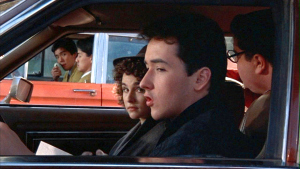 When obsessive teenager Lane Meyer (John Cusack)’s girlfriend Beth (Amanda Wyss) breaks up with him for obnoxiously handsome ski team captain Roy Stalin (Aaron Dozier), he begins to contemplate suicide. As if that wasn’t funny enough, he is stalked by a tough talking paperboy, harassed by a pair of Japanese drag racing enthusiasts (including Yee Sook Ree from Karate Kid 2), and outshone in every way by his wunderkind seven year old brother who entertains older women and builds a space shuttle out of household appliances. But when the crass mother of his creepy next door neighbor Ricky (Dan Schneider of Head Of The Class) takes on a cute French foreign exchange student (the gorgeous Diane Franklin), things start looking up.
When obsessive teenager Lane Meyer (John Cusack)’s girlfriend Beth (Amanda Wyss) breaks up with him for obnoxiously handsome ski team captain Roy Stalin (Aaron Dozier), he begins to contemplate suicide. As if that wasn’t funny enough, he is stalked by a tough talking paperboy, harassed by a pair of Japanese drag racing enthusiasts (including Yee Sook Ree from Karate Kid 2), and outshone in every way by his wunderkind seven year old brother who entertains older women and builds a space shuttle out of household appliances. But when the crass mother of his creepy next door neighbor Ricky (Dan Schneider of Head Of The Class) takes on a cute French foreign exchange student (the gorgeous Diane Franklin), things start looking up.
Why I Bought It:
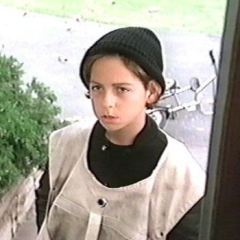
Didn’t ask for a dime….two dollars.
Re-reading that synopsis I just wrote (and re-watching auteur Savage Steve Holland’s 80’s classic after at least a decade hiatus), Better Off Dead would probably never fly today. One of its running jokes is a teenager’s repeated attempts to do himself in. Other hilarities touched upon include molesting a foreign exchange student, knocking a ten year old kid off a mountainside, the pursuit of Lane’s teenage ex-girlfriend by everybody from a mystifyingly popular Geometry teacher (played by the late great Vincent Schiavelli) and a creepy mailman (comedian Taylor Negron) to Barney Rubble (himself), and Lane’s buddy Charles De Mar’s (Curtis Armstrong) perennial quest to find a substitute for cocaine.
Yet, I saw this when I was ten or eleven years old and loved it, sorely identifying with the put upon Lane and still laughing at the absurdities of his life. Cusack plays Lane with the stoic acceptedness of Buster Keaton, the bumbling straight man who is the only guy in the movie that doesn’t get the joke.
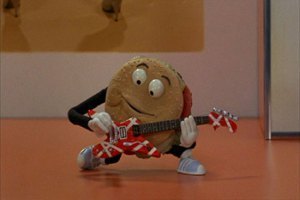 Holland alternately peppers Better Off Dead with helpings of real awkwardness (Lane’s flashback meeting with Beth, where both her and Lane’s self-conscious inner thoughts can be heard) and romance, and then blasts it with some really out there zaniness. Lane’s mom boils bacon green and appears to be steaming a star spawn of Cthulhu in a pot at one point. She passes out gift wrapped stacks of Stouffer’s frozen dinners for Christmas and serves a French-themed dinner consisting of fries, bread, dressing, and “Peru” (Perrier water). Gangs of murderous paperboys pursue Lane through an ominous back-lit nightscape, and a claymation cheeseburger David Lee Roth shreds across his workstation. Even Lane’s own sketchbook doodles berate him.
Holland alternately peppers Better Off Dead with helpings of real awkwardness (Lane’s flashback meeting with Beth, where both her and Lane’s self-conscious inner thoughts can be heard) and romance, and then blasts it with some really out there zaniness. Lane’s mom boils bacon green and appears to be steaming a star spawn of Cthulhu in a pot at one point. She passes out gift wrapped stacks of Stouffer’s frozen dinners for Christmas and serves a French-themed dinner consisting of fries, bread, dressing, and “Peru” (Perrier water). Gangs of murderous paperboys pursue Lane through an ominous back-lit nightscape, and a claymation cheeseburger David Lee Roth shreds across his workstation. Even Lane’s own sketchbook doodles berate him.
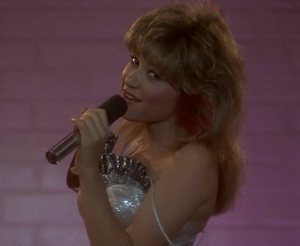 The supporting cast is just as likable as Cusack. I’ve got to mention two of my three biggest 1980’s coming of age crushes were in this flick together, the doll-faced, sweet but scrappy voiced Elizabeth Daily, who sings the title song at the high school dance and was Pee Wee Herman’s admirer Dottie in Pee Wee’s Big Adventure (and who, amazingly, looks even better now than she did then), and Diane Franklin who plays Monique, and seriously shot me through the heart Bon Jovi style in the scene where she starts Lane’s long dormant Camaro.
The supporting cast is just as likable as Cusack. I’ve got to mention two of my three biggest 1980’s coming of age crushes were in this flick together, the doll-faced, sweet but scrappy voiced Elizabeth Daily, who sings the title song at the high school dance and was Pee Wee Herman’s admirer Dottie in Pee Wee’s Big Adventure (and who, amazingly, looks even better now than she did then), and Diane Franklin who plays Monique, and seriously shot me through the heart Bon Jovi style in the scene where she starts Lane’s long dormant Camaro. 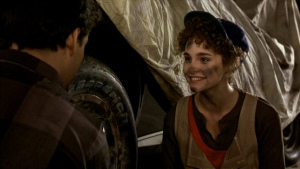 That image of her in the Dodger’s cap and coveralls, that bright smile shining through that motor oil was indelible. The other, in case you’re wondering, was Kerri Green in Lucas, who was just poetry to an adolescent boy.
That image of her in the Dodger’s cap and coveralls, that bright smile shining through that motor oil was indelible. The other, in case you’re wondering, was Kerri Green in Lucas, who was just poetry to an adolescent boy.
Curtis Armstrong and Dan Schneider are both pretty hilarious in this movie, with Curtis being a bit of a scene stealer, and Schneider underplaying what could’ve easily been a very unseemly role, yet somehow in the end winds up sympathetic. Aaron Dozier’s Roy Stalin is a typical 80′s slimeball villain, a caricature of Johnny from Karate Kid, but he plays it to the hilt with his perfectly styled hair, ridiculously straight teeth, and obnoxious line delivery (“Lookin’ GOOD, Meyer. Lookin’ REAL GOOD.”) 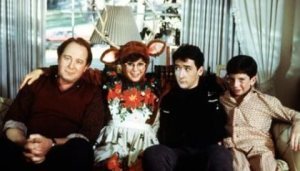 Lane’s father, played by David Ogden Stiers, seems at times, as he should, like an adult version of Lane, just world weary with the weirdness of his wife and children (“WHAT in the name of ALL that is HOLY?”), yet himself a source of comedy with his terrible attempts at employing youthful slang and his war with the paperboy over the sanctity of his garage door windows. Kim Darby, as mentioned, is hilarious as a slightly psychotic Suzy Homemaker.
Lane’s father, played by David Ogden Stiers, seems at times, as he should, like an adult version of Lane, just world weary with the weirdness of his wife and children (“WHAT in the name of ALL that is HOLY?”), yet himself a source of comedy with his terrible attempts at employing youthful slang and his war with the paperboy over the sanctity of his garage door windows. Kim Darby, as mentioned, is hilarious as a slightly psychotic Suzy Homemaker.
I’m a sucker for 80′s movie music too, and this soundtrack has some great songs you won’t hear anywhere else the aformentioned Elizabeth Daily’s two tracks, “One Way Love (Better Off Dead)” and “A Little Luck,” Rupert Hine’s “I’ve Been Arrested By You,” and in particular, Howard Jones’ “Like To Get To Know You Well” are excellent, nostalgic tracks, to say nothing of Muddy Waters’ “Mannish Boy” and Van Halen’s thunderous ”Everybody Wants Some.”
My friends and I quoted this movie up and down when I was growing up (“Meyer? Is that like in Oscar Meyer? Hey Beth, is he your main wiener man?” “Do you know what the street value of this mountain is?” “Gee I’m real sorry your mom blew up, Ricky. The doctors said she’ll be OK, I guess she just can’t eat any spicy foods for awhile,” and “Lane, I’ve been going to this school for seven and a half years. I’m no dummy.”), and though the political correctedness of the subject matter may have changed, for the most part it’s not too badly dated.
 I dare say the overall theme might even still speak to depressed teens today, as it once did to me. That theme is, much of life’s seemingly most insurmountable tribulations are inherently absurd. Don’t take everything so serious.
I dare say the overall theme might even still speak to depressed teens today, as it once did to me. That theme is, much of life’s seemingly most insurmountable tribulations are inherently absurd. Don’t take everything so serious.
In other words, go that way really fast. If something gets in your way, turn.
Best Dialogue:
When Lane comes home and discovers an angry Monique pitching oranges at a No Parking sign, she confesses to him that she speaks English (she has been faking a lack of fluency in order to avoid Ricky and his mom).
Monique: I figured if we had nothing to say to each other, he would get bored, go away. Instead he uses every excuse to put his testicles all over me.
Lane: Excuse me?
Monique: How do you say? You know, like Octopus? Testicles?
Lane: Oh…Tentacles. N-T. Tentacles. Big difference.
Best Scene:
There are a lot to choose from (Charles’ uncontrollable, continuous laughter at the dance when Stalin rips on him and Lane as “his vote for cutest couple…but you better shave her before you take her home” is one), but the scene that always comes to mind for me is one of Lane’s numerous suicide attempts.
Lane stands on the top step in his garage, contemplating his own demise. After looping a bungie cord around his neck and throwing it over the ceiling beam, he suddenly looks up and says;
“Hey wait a minute here. This is death here. I can’t do this. I’ve never even been to New York City. I’ve never been anywhere.”
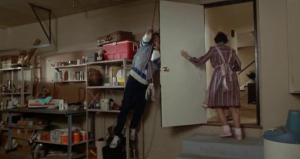 As he begins to take the makeshift noose off, his mother opens the door and walks backwards into the garage, running the vacuum as she cleans the hallway. When the door opens she nudges him off the garage steps, then whaps him with the door a couple times as he dangles behind the door, struggling.
As he begins to take the makeshift noose off, his mother opens the door and walks backwards into the garage, running the vacuum as she cleans the hallway. When the door opens she nudges him off the garage steps, then whaps him with the door a couple times as he dangles behind the door, struggling.
It still cracks me up, and is very indicative of Lane’s overall plight as an overwrought teenager saddled with mainly oblivious parents.
Would I Buy It Again? Yes, though full disclosure, I almost never purchase comedies (I usually have terrible luck with them) – this was a gift from my wife, who knows me better than I know myself sometimes.
Next In The Queue: Big Trouble In Little China



